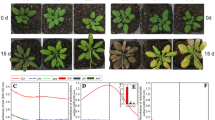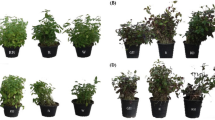Abstract
Boron (B) toxicity is an important agricultural problem in arid environments. Excess edaphic B compromises photosynthetic efficiency, limits growth and reduces crop yield. However, some purple-leafed cultivars of sweet basil (Ocimum basilicum) exhibit greater tolerance to high B concentrations than do green-leafed cultivars. We hypothesised that foliar anthocyanins protect basil leaf mesophyll from photo-oxidative stress when chloroplast function is compromised by B toxicity. Purple-leafed ‘Red Rubin’ and green-leafed ‘Tigullio’ cultivars, grown with high or negligible edaphic B, were given a photoinhibitory light treatment. Possible effects of photoabatement by anthocyanins were simulated by superimposing a purple polycarbonate filter on the green leaves. An ameliorative effect of light filtering on photosynthetic quantum yield and on photo-oxidative load was observed in B-stressed plants. In addition, when green protoplasts from both cultivars were treated with B and illuminated through a screen of anthocyanic protoplasts or a polycarbonate film which approximated cyanidin-3-O-glucoside optical properties, the degree of photoinhibition, hydrogen peroxide production, and malondialdehyde content were reduced. The data provide evidence that anthocyanins exert a photoprotective role in purple-leafed basil mesophyll cells, thereby contributing to improved tolerance to high B concentrations.







Similar content being viewed by others
Abbreviations
- Φ PSII :
-
Quantum yield of photosystem II
- Chl:
-
Chlorophyll
- DCFH-DA:
-
2′,7′-Dichlorofluorescein diacetate
- DCF:
-
2′,7′-Dichlorofluorescein
- ETR:
-
Electron transport rate
- F v/F m :
-
Maximal quantum yield of photosystem II
- MDA:
-
Malondialdehyde
- MES:
-
2-(N-morpholino)ethanesulfonic acid
- NPQ:
-
Non-photochemical quenching
- PSII:
-
Photosystem II
- q P :
-
Photochemical quenching coefficient
- ROS:
-
Reactive oxygen species
- TBA:
-
Thiobarbituric acid
- TCA:
-
Trichloroacetic acid
References
Andersen ØM, Jordheim M (2006) The anthocyanins. In: Anderson OM, Markham KR (eds) Flavonoids. Chemistry, biochemistry and applications. CRC Press, Boca Raton, pp 471–530
Asada K (1999) The water-water cycle in chloroplasts: scavenging of active oxygens and dissipation of excess photons. Annu Rev of Plant Physiol Plant Mol Biol 50:601–639
Bi Y, Chen W, Zhang W, Zhou Q, Yun L, Xing D (2009) Production of reactive oxygen species, impairment of photosynthetic function and dynamic changes in mitochondria are early events in cadmium-induced cell death in Arabidopsis thaliana. Biol Cell 101:629–643
Bradford MM (1976) A rapid and sensitive method for the quantitation of microgram quantities of protein utilizing the principle of protein-dye binding. Anal Biochem 72:248–254
Buchweitz M, Gudi G, Carle R, Kammerer DR, Schulz H (2012) Systematic investigation of anthocyanin-metal interactions by Raman spectroscopy. J Raman Spectrosc 43:2001–2007
Cervilla LM, Blasco B, Ríos JJ, Romero L, Ruiz JM (2007) Oxidative stress and antioxidants in tomato (Solanum lycopersicum) plants subjected to boron toxicity. Ann Bot 100:747–756
Chalker-Scott L (1999) Environmental significance of anthocyanins in plants stress response. Photochem Photobiol 70:1–9
D’Onofrio C, Morini S, Vitigliano C (1999) Isolation of protoplasts from in vitro-grown quince BA29 leaves. In Vitro Cell Dev Biol 35:421–423
Dannel F, Pfeffer H, Römheld V (1998) Compartmentation of boron in roots and leaves of sunflower as affected by boron supply. J Plant Physiol 153:615–622
Demmig-Adams B, Adams WW III (2006) Photoprotection in an ecological context: the remarkable complexity of thermal energy dissipation. New Phytol 172:11–21
Elhabiri M, Figueiredo P, Toki K, Saito N, Brouillard R (1997) Anthocyanin-aluminium and -gallium complexes in aqueous solution. J Chem Soc Perkin Trans 2:355–362
Genty B, Briantais JM, Baker NR (1989) The relationship between the quantum yield of photosynthetic electron transport and quenching of chlorophyll fluorescence. Biochim Biophys Acta 990:87–92
Gould KS (2004) Nature’s Swiss army knife: the diverse protective roles of anthocyanins in leaves. J Biomed Biotech 5:314–320
Gould KS, McKelvie J, Markham KR (2002a) Do anthocyanins function as antioxidants in leaves? Imaging of H2O2 in red and green leaves after mechanical injury. Plant Cell Environ 25:1261–1269
Gould KS, Vogelmann TC, Han T, Clearwater MJ (2002b) Profiles of photosynthesis within red and green leaves of Quintinia serrata A. Cunn. Physiol Plant 116:127–133
Gould KS, Davies K, Winefield C (2009) Anthocyanins: biosynthesis, functions and applications. Springer, Dordrecht
Guidi L, Degl’Innocenti E, Giordano C, Biricolti S, Tattini M (2010) Ozone tolerance in Phaseolus vulgaris depends on more than one mechanism. Environ Poll 158:3164–3171
Guidi L, Degl’Innocenti E, Carmassi G, Massa D, Pardossi A (2011) Effects of boron on leaf chlorophyll fluorescence of greenhouse tomato grown with saline water. Environ Exp Bot 73:57–63
Hale KL, McGrath S, Lombi E, Stack S, Terry N, Pickering IJ, George GN, Pilon-Smits EAH (2001) Molybdenum sequestration in Brassica: a role for anthocyanins? Plant Physiol 126:1391–1402
Hale KL, Tufan HA, Pickering IJ, George GN, Terry N, Pilon M, Pilon-Smits EAH (2002) Anthocyanins facilitate tungsten accumulation in Brassica. Physiol Plant 116:351–358
Hatier J-HB, Clearwater MJ, Gould KS (2013) The functional significance of black-pigmented leaves: photosynthesis, photoprotection and productivity in Ophiopogon planiscapus ‘Nigrescens’. PLoS One 8:1–5
Hughes NM, Burkey KO, Cavender-Bares J, Smith WK (2012) Xanthophyll cycle pigment and antioxidant profiles of winter-red (anthocyanic) and winter-green (acyanic) angiosperm evergreen species. J Exp Bot 63:1895–1905
Jingxian Z, Kirkham MB (1996) Antioxidant response to drought in sunflower and sorghum seedlings. New Phytol 132:361–373
Krall JP, Edwards GE (1992) Relationship between photosystem II activity and CO2 fixation. Physiol Plant 86:180–187
Kyparissis A, Grammatikopoulos G, Manetas Y (2007) Leaf morphological and physiological adjustments to the spectrally selective shade imposed by anthocyanins in Prunus cerasifera. Tree Physiol 27:849–857
Kytridis VP, Manetas Y (2006) Mesophyll versus epidermal anthocyanins as potential in vivo antioxidants: evidence linking the putative antioxidant role to the proximity of oxy-radical source. J Exp Bot 57:2203–2210
Kytridis VP, Karageorgou P, Levizou E, Manetas Y (2008) Intra-species variation in transient accumulation of leaf anthocyanins in Cistus creticus during winter: evidence that anthocyanins may compensate for an inherent photosynthetic and photoprotective inferiority of the red-leaf phenotype. J Plant Physiol 165:952–959
Landi M, Pardossi A, Remorini D, Guidi L (2013a) Antioxidant and photosynthetic response of a purple-leaves and a green-leaved cultivar of sweet basil (Ocimum basilicum) to boron excess. Environ Exp Bot 85:64–75
Landi M, Remorini D, Pardossi A, Guidi L (2013b) Purple versus green-leafed genotypes of sweet basil (Ocimum basilicum): which differences occur in photosynthesis under boron toxicity? J Plant Nut Soil Sci 176:942–951
Landi M, Remorini D, Pardossi A, Guidi L (2013c) Boron excess affects photosynthesis and antioxidant apparatus of greenhouse Cucurbita pepo and Cucumis sativus. J Plant Res 126:775–786
Lichtenthaler HK (1987) Chlorophylls and carotenoids: pigments of photosynthetic biomembranes. Meth Enzymol 148:350–382
Lichtenthaler HK, Babani F, Langdorf G, Buschmann C (2000) Measurement of differences in red chlorophyll fluorescence and photosynthetic activity between sun and shade leaves by fluorescence imaging. Photosynthetica 38:521–529
Lovatts CJ, Bates LM (1984) Early effects of excess boron on photosynthesis and growth of Cucurbita pepo. J Exp Bot 35:297–305
Makri O, Kintzios S (2007) Ocimum spp. (basil): botany, cultivation, pharmaceutical properties and biotechonology. J Herbs Spices Med Plants 13:123–150
Manetas Y, Drinia A, Petropoulou Y (2002) High contents of anthocyanins in young leaves are correlated with low pools of xanthophyll cycle components and low risk of photoinhibition. Photosynthetica 40:349–354
Manetas Y, Petropoulou Y, Psaras GK, Drinia A (2003) Exposed red (anthocyaninc) leaves of Quercus coccifera display shade characteristics. Funct Plant Biol 30:265–270
Matoh T, Takasaki M, Kobayashi M, Takabe K (2000) Boron nutrition of cultured tobacco BY-2 cells. III. Characterization of the boron-rhamnogalacturonan II complex in cells acclimated to low levels of boron. Plant Cell Physiol 41:363–366
Mittler R, Vanderauwera S, Gollery M, Breusegem FV (2004) Reactive oxygen gene network of plants. Trends Plant Sci 9:490–498
Mullineaux PM, Karpinski S, Backer NR (2006) Spatial dependence for hydrogen peroxide-directed signalling in light-stressed plants. Plant Physiol 141:346–350
Nable RO, Banuelos GS, Paull JG (1997) Boron toxicity. Plant Soil 198:181–198
Neill SO, Gould KS (2003) Anthocyanins in leaves: light attenuators or antioxidants? Funct Plant Biol 30:865–873
Niyogi KK, Li X-P, Rosenberg V, Jung H-S (2005) Is PsbS the site of non-photochemical quenching in photosynthesis? J Exp Bot 56:375–382
Reid R (2007) Identification of boron transporter genes likely to be responsible for tolerance to boron toxicity in wheat and barley. Plant Cell Physiol 48:1673–1678
Reid RJ, Hayes JE, Post A, Stangoulis JCR, Graham RD (2004) A critical analysis of the causes of boron toxicity in plants. Plant Cell Environ 27:1405–1414
Ryan J, Singh M, Yau SK (1998) Spatial variability of soluble boron in Syrian soils. Soil Tillage Res 45:407–417
Schreiber U, Schliva U, Bilger B (1986) Continuous recording of photochemical and non-photochemical chlorophyll fluorescence quenching with a new type of modulation fluorometer. Photosynth Res 10:51–62
Somaatmadja D, Powers JJ, Hamdy MH (2006) Anthocyanins. VI. Chelation studies on anthocyanins and other related compounds. J Food Sci 29:655–660
Steyn WJ, Wand SJE, Holcroft DM, Jacobs G (2002) Anthocyanins in vegetative tissues: a proposed unified function in photoprotection. New Phytol 155:349–361
Tate SS, Meister A (1978) Serine-borate complex as a transition-state inhibitor of γ-glutamyl transpeptidase. Proc Natl Acad Sci USA 75: 4806–4809
Tattini M., Landi M., Brunetti C, Giordano C, Remorini D, Gould KS, Guidi L (2014) Epidermal coumaroyl anthocyanins protect sweet basil against excess light stress: multiple consequences of light attenuation. Physiol Plant (in press)
Wolf B (1974) Improvement in the azomethine-H method for determination of boron. Commun Soil Sci Plant Anal 5:39–44
Yamasaki H (1997) A function of color. Trend Plant Sci 2:7–8
Zeliou K, Manetas Y, Petropoulou Y (2009) Transient winter leaf reddening in Cistus creticus characterizes weak (stress-sensitive) individuals, yet anthocyanins cannot alleviate the adverse effects on photosynthesis. J Exp Bot 60:3031–3042
Acknowledgments
This work was funded in part by MIUR-PRIN 2009 (Ministero dell’Istruzione, dell’Università e della Ricerca, Italy, Project number 20093R8JLB).
Author information
Authors and Affiliations
Corresponding author
Additional information
Special topic: Anthocyanins. Guest editor: Stefan Martens.
Rights and permissions
About this article
Cite this article
Landi, M., Guidi, L., Pardossi, A. et al. Photoprotection by foliar anthocyanins mitigates effects of boron toxicity in sweet basil (Ocimum basilicum). Planta 240, 941–953 (2014). https://doi.org/10.1007/s00425-014-2087-1
Received:
Accepted:
Published:
Issue Date:
DOI: https://doi.org/10.1007/s00425-014-2087-1




